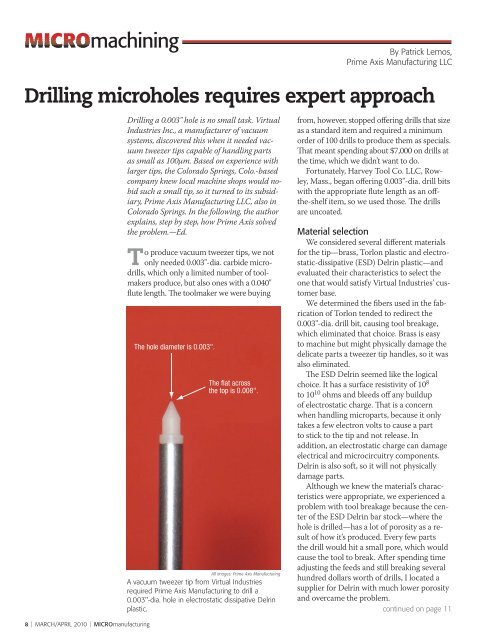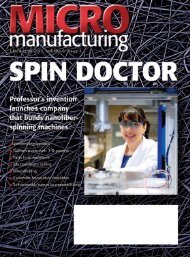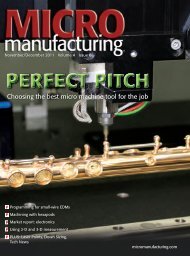Click here to view as PDF - MICROmanufacturing
Click here to view as PDF - MICROmanufacturing
Click here to view as PDF - MICROmanufacturing
Create successful ePaper yourself
Turn your PDF publications into a flip-book with our unique Google optimized e-Paper software.
MICROmachining<br />
By Patrick Lemos,<br />
Prime Axis Manufacturing LLC<br />
Drilling microholes requires expert approach<br />
8 | MARCH/APRIL 2010 | <strong>MICROmanufacturing</strong><br />
Drilling a 0.003" hole is no small t<strong>as</strong>k. Virtual<br />
Industries Inc., a manufacturer of vacuum<br />
systems, discovered this when it needed vacuum<br />
tweezer tips capable of handling parts<br />
<strong>as</strong> small <strong>as</strong> 100μm. B<strong>as</strong>ed on experience with<br />
larger tips, the Colorado Springs, Colo.-b<strong>as</strong>ed<br />
company knew local machine shops would nobid<br />
such a small tip, so it turned <strong>to</strong> its subsidiary,<br />
Prime Axis Manufacturing LLC, also in<br />
Colorado Springs. In the following, the author<br />
explains, step by step, how Prime Axis solved<br />
the problem.—Ed.<br />
To produce vacuum tweezer tips, we not<br />
only needed 0.003"-dia. carbide microdrills,<br />
which only a limited number of <strong>to</strong>olmakers<br />
produce, but also ones with a 0.040"<br />
flute length. The <strong>to</strong>olmaker we were buying<br />
The hole diameter is 0.003".<br />
The flat across<br />
the <strong>to</strong>p is 0.008".<br />
from, however, s<strong>to</strong>pped offering drills that size<br />
<strong>as</strong> a standard item and required a minimum<br />
order of 100 drills <strong>to</strong> produce them <strong>as</strong> specials.<br />
That meant spending about $7, 000 on drills at<br />
the time, which we didn’t want <strong>to</strong> do.<br />
Fortunately, Harvey Tool Co. LLC, Rowley,<br />
M<strong>as</strong>s., began offering 0.003"-dia. drill bits<br />
with the appropriate flute length <strong>as</strong> an offthe-shelf<br />
item, so we used those. The drills<br />
are uncoated.<br />
Material selection<br />
We considered several different materials<br />
for the tip—br<strong>as</strong>s, Torlon pl<strong>as</strong>tic and electrostatic-dissipative<br />
(ESD) Delrin pl<strong>as</strong>tic—and<br />
evaluated their characteristics <strong>to</strong> select the<br />
one that would satisfy Virtual Industries’ cus<strong>to</strong>mer<br />
b<strong>as</strong>e.<br />
We determined the fibers used in the fabrication<br />
of Torlon tended <strong>to</strong> redirect the<br />
0.003"-dia. drill bit, causing <strong>to</strong>ol breakage,<br />
which eliminated that choice. Br<strong>as</strong>s is e<strong>as</strong>y<br />
<strong>to</strong> machine but might physically damage the<br />
delicate parts a tweezer tip handles, so it w<strong>as</strong><br />
also eliminated.<br />
The ESD Delrin seemed like the logical<br />
choice. It h<strong>as</strong> a surface resistivity of 10 8<br />
<strong>to</strong> 10 10 ohms and bleeds off any buildup<br />
of electrostatic charge. That is a concern<br />
when handling microparts, because it only<br />
takes a few electron volts <strong>to</strong> cause a part<br />
<strong>to</strong> stick <strong>to</strong> the tip and not rele<strong>as</strong>e. In<br />
addition, an electrostatic charge can damage<br />
electrical and microcircuitry components.<br />
Delrin is also soft, so it will not physically<br />
damage parts.<br />
Although we knew the material’s characteristics<br />
were appropriate, we experienced a<br />
problem with <strong>to</strong>ol breakage because the center<br />
of the ESD Delrin bar s<strong>to</strong>ck—w<strong>here</strong> the<br />
hole is drilled—h<strong>as</strong> a lot of porosity <strong>as</strong> a result<br />
of how it’s produced. Every few parts<br />
the drill would hit a small pore, which would<br />
cause the <strong>to</strong>ol <strong>to</strong> break. After spending time<br />
adjusting the feeds and still breaking several<br />
hundred dollars worth of drills, I located a<br />
supplier for Delrin with much lower porosity<br />
and overcame the problem.<br />
All images: Prime Axis Manufacturing<br />
A vacuum tweezer tip from Virtual Industries<br />
required Prime Axis Manufacturing <strong>to</strong> drill a<br />
0.003"-dia. hole in electrostatic dissipative Delrin<br />
pl<strong>as</strong>tic. continued on page 11















